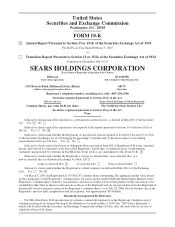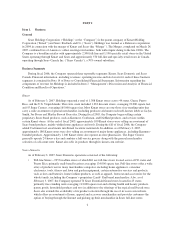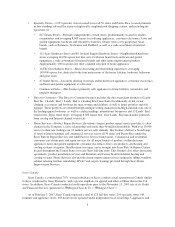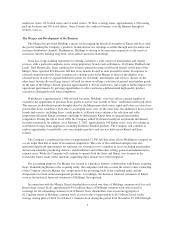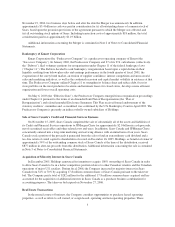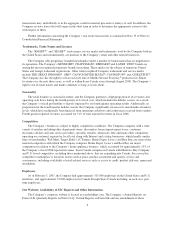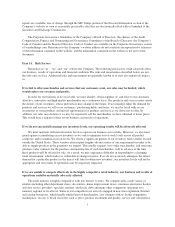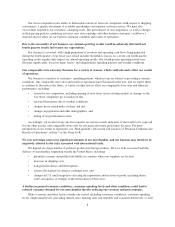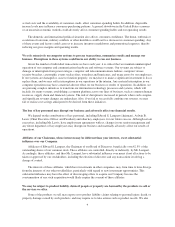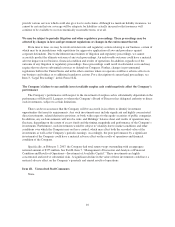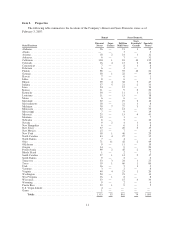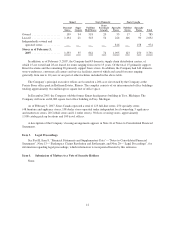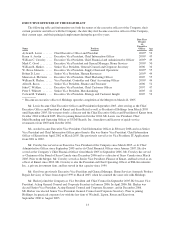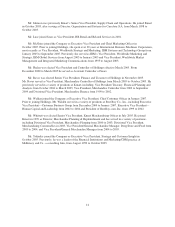Sears 2006 Annual Report Download - page 4
Download and view the complete annual report
Please find page 4 of the 2006 Sears annual report below. You can navigate through the pages in the report by either clicking on the pages listed below, or by using the keyword search tool below to find specific information within the annual report.mattresses stores, 28 Corbeil stores and 11 outlet stores), 50 floor covering stores, approximately 1,900 catalog
pick-up locations and 100 travel offices. Sears Canada also conducts business over the Internet through its
website, sears.ca.
The Merger and Development of the Business
The Merger has provided Holdings a means for leveraging the historical strengths of Kmart and Sears with
the goal of making the Company’s products, brands and service offerings available through more locations and
customer distribution channels. Furthermore, Holdings is striving to become more responsive to the needs of
customers, thereby building long-term, value-added customer relationships.
Sears has a long-standing reputation for offering customers a wide variety of merchandise and related
services, with a particular emphasis on its strong proprietary brands such as Kenmore, Craftsman, DieHard and
Lands’ End. Historically, Sears conducted its business primarily using a mall-based format. At the time of the
Merger, Sears operated 874 domestic full-line stores mainly located in such on-mall locations. In response to
off-mall competitor growth, Sears commenced a strategy prior to the Merger to increase the number of its
off-mall stores in order to expand distribution points for its brands, merchandise and services. Kmart, on the
other hand, historically used large format, off-mall locations in selling a selection of general merchandise goods.
At the time of the Merger, Kmart operated approximately 1,400 off-mall stores and sought to further improve its
operational performance by pursuing opportunities to offer customers a differentiated high-quality product
selection to distinguish itself from competitors.
With Kmart’s approximately 1,400 off-mall locations, Holdings’ store base offers a greater number of
customers the opportunity to purchase Sears products and services outside of Sears’ traditional mall-based stores.
This increase in distribution points brought about by the Merger provided a more rapid and lower-cost store base
growth than Sears would have been able to accomplish on its own. At the same time, the addition of Sears-owned
brands and services, including Sears’ credit products, to Kmart stores enhances the selection and value
proposition offered to Kmart customers and helps to differentiate Kmart from its general merchandise
competitors. During the fall of fiscal 2006, the Company added Craftsman brand tool assortments into Kmart
locations nationwide. In addition, as of February 3, 2007, approximately 180 Kmart stores were also selling an
assortment of major home appliances, including Kenmore-branded products. The Company will continue to
explore opportunities to profitably cross-merchandise products and services between its Kmart and Sears
formats.
The Company’s combined store base of approximately 2,300 full-line stores allows Holdings to compete on
a scale larger than that of many of its national competitors. The scale of the combined enterprise has also
generated significant opportunities for realizing cost synergies across a number of areas, including merchandise
and non-merchandise purchasing, delivery and distribution and within other selling, general and administrative
expense areas. While the Company will continue to operate both the Sears and Kmart store formats in the
foreseeable future, many of the functions supporting these formats have been integrated.
For accounting purposes, the Merger was treated as a purchase business combination, with Kmart acquiring
Sears. In identifying Kmart as the acquiring entity, the companies took into account the relative share ownership
of the Company after the Merger, the composition of the governing body of the combined entity and the
designation of certain senior management positions. Accordingly, the historical financial statements of Kmart
serve as the historical financial statements of Holdings, the registrant.
In connection with the Merger, Kmart shareholders received one share of Holdings common stock for each
Kmart share owned. In all, approximately 94.9 million shares of Holdings common stock were issued in
exchange for all outstanding common stock of Kmart. Sears shareholders were issued an aggregate of
62.2 million shares of Holdings common stock at a total value of approximately $6.5 billion (based on the
average closing price of $104.33 of Kmart’s common stock during the period from November 15, 2004 through
4

